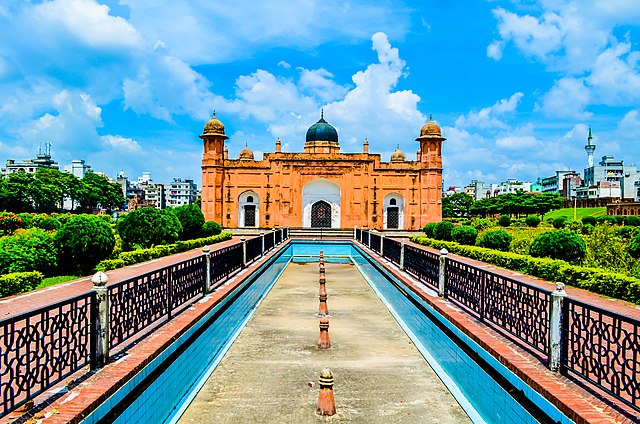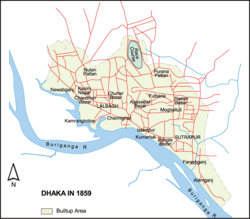Loading AI tools
Historical territory of the city of Dhaka From Wikipedia, the free encyclopedia
Old Dhaka (Bengali: পুরান ঢাকা, romanized: Puran Dhaka) is a term used to refer to the historic old city of Dhaka, the capital of Bangladesh.[2] It was founded in 1608 as Jahangirabad or Jahangirnagar (Bengali: জাহাঙ্গীরনগর, romanized: Jahangirnogor, lit. 'City of Jahangir'), the capital of Mughal Province of Bengal and named after the Mughal emperor Jahangir. It is located on the banks of the Buriganga River. It was one of the largest and most prosperous cities of the Indian subcontinent and the center of the worldwide muslin trade. The then Nawab of Bengal Murshid Quli Khan shifted the capital from Dhaka to Murshidabad in the early-18th century. With the rise of Calcutta (now Kolkata) during the British rule, Dhaka began to decline and came to be known as the "City of Magnificent Ruins". The British however began to develop the modern city from the mid-19th century.[3]


Old Dhaka
পুরান ঢাকা | |
|---|---|
 Dhaka City across Buriganga River in a 1861 painting[1] | |
 Map of Old Dhaka during British rule | |
| Coordinates: 23°42′25″N 90°24′34″E | |
| Country | |
| District | Dhaka District |
| City Corporation | Dhaka South City Corporation |
| Settlement | Around 700 CE |
| Establishment | 1608 CE |
| Expansion | After 1910 CE |
Old Dhaka is famous for its variety of foods and amicable living of people of all religions in harmony. The main Muslim festivals celebrated with funfair here are Eid-ul-Fitr, Eid-ul-Adha and Ashura,[4] Hindu festivals like Durga Puja,[5] Kali Puja, and Saraswati Puja[6] are also celebrated with enthusiasm. The festivals which are celebrated by all religious communities with much splendor include Shakrain (পৌষ সংক্রান্তি), Pohela Falgun,[7] and Halkhata (হালখাতা). Religion-wise, the old Dhaka is predominantly Muslim, while a significant number of Hindus also reside here. Christians and Buddhists are also inhabitants here in small numbers. Its inhabitants are known as the demonym Dhakaiya and converse in the Dhakaiya Kutti, a dialect of Bengali and Dhakaiya Urdu, a dialect of Urdu.


The existence of a settlement in the area that is now Dhaka dates from the 7th century. The city area was ruled by the Buddhist kingdom of Kamarupa and the Pala Empire before passing to the control of the Hindu Sena dynasty in the 9th century. The name of the town may have derived after the establishment of the Goddess Dhakeshvari's temple by Ballal Sena in the 12th century.[citation needed]
After the Sena Empire, Dhaka was ruled by the Delhi Sultanate (sometimes tenuously), then by the Bengal Sultanate, before being taken over by the Mughals in 1576.[8] Dhaka started to grow from 1610 under the Mughal Subedars.[9] The oldest standing mosque was built in 1454 by Bakht Binat during the rule of Nasiruddin Mahmud Shah.[9]
The development of townships and housing has resulted in a significant growth in population came as the city was proclaimed the capital (replacing Rajmahal) of Bengal Subah under Mughal rule in 1608. Mughal Subahdar Islam Khan was the first administrator of the city. Khan named the town "Jahangirabad" (জাহাঙ্গীরাবাদ; City of Jahangir) in honour of the Mughal Emperor Jahangir, although this name was dropped soon after Jahangir's death. Farashganj (French town) was settled by the French 1780, then known as French Market. The area is known for its 19th and early 20th century mansions.[10] Farashganj also had the presence of French East India Company.[11] The 18th and 19th century saw significant number of Armenians settle down in Armanitola, then a predominantly Armenian neighborhood. There is an Armenian Church in Armanitola.[12] The British converted an old Afghan fort into a Central Jail in 1820.[9] Das Babu, prominent merchant had a daughter Indira, whose tomb is present here. Indira road is named after her and not after Indira Gandhi as some mistakenly believe it to be.[9] Pogose School, was founded by Armenian businessman Nicholas Pogose, as the first private school in Dhaka.[13] The national political party, Bangladesh Awami League, was founded in Rose Garden Palace on 23 June 1949.[14]
The area saw rise in drug abuse, especially Ya Ba and Phensedyl.[15][16] Old Dhaka has a large number of chemical, plastic, electrical goods factories, and printing presses. The government of Bangladesh is trying to relocate them out of Old Dhaka.[17] In 2010 a fire that was flamed by chemical warehouse killed more than hundred people and increased the calls for chemical factories and warehouse to be moved from the area.[18] The narrow lanes make it difficult for fire trucks to reach fires in the area and many of them are narrow to even fit a fire truck.[19] Dhaka's Third Special Judge's Court is located in Bakshibazar, Old Dhaka.[20] Ansarullah Bangla Team attacked a police check post, leaving two cops injured and the capture of one terrorist on 1 February 2017.[21] It fell under the jurisdiction of Dhaka South City Corporation after the administrative division of Dhaka.[22]
Many of the British and Mughal era buildings of old Dhaka face the risk of being knocked down to be replaced with modern apartment buildings. Conservationist are trying to preserve them but the government of Bangladesh has shown little interest in preserving them.[23][24] The government declared Shankhari Bazaar a heritage site in 2013, which met resistance from the residents who wanted to expand the buildings.[25] In 2014 a mosque built in 1707 was demolished leading to controversy and criticism.[26] Government run schools are in a depleted condition in Old Dhaka as of 2015.[27] In 2016 the three hundred-year-old Gorostan Shahi Mosque was demolished to build a new structure.[28] Many of the buildings are demolished because RAJUK and the Archaeological Department of the government did not list them as historical buildings which would have protected them.[29]

Architecture
Bahadur Shah Park is a 19th-century park that serves as an exercise ground for the residents. Sadarghat is the river terminal of Dhaka City. Shankhari Bazaar is a historically Hindu neighborhood known for its Shakhari (conch musical instrument) makers.[30] The Shakhari also make bangles from the shells. The shops are in decline as many news to buy cheaper bangles made from artificial shell.[31] Northbrook Hall auditorium was founded in 1881; it holds art exhibitions.[32] Pohela Falgun is celebrated in old Dhaka.[33] Bulbul Academy of Fine Arts is a historic art school in Old Dhaka.[34] The Dhaka Central Jail, which has been closed down now houses a museum.[35] The jail was founded in 1788 as a criminal ward. when it closed in 2016 it housed over 8 thousand prisoners.[36] Shakrain is a festival of kite in Old Dhaka. It marks the end of Poush, the first month of winter in Bangladesh.[37] It also involves rooftop parties, fire-breathing, and fireworks.[38] Bongshal Pond is Tanti Bazaar is a community pool and gathering spot.[39] Chaand Raat (the night before eid) is celebrated here with fireworks and Adda (hangout).[40] Taazia processions are held by Shia Muslims on the occasion of Muharram near Hossaaini and Barha Katra.[4] There are 12 musical schools in Old Dhaka.[41] Old Dhaka has a sense of community where neighbors know each other and that differentiate it from new Dhaka.[42] During Durge Puja some parts of Old Dhaka are brightly decorated and people play drums in the streets.[43]
Old Dhaka is famous for its biriyani, morog polau, and kebabs.[44] Morog (Chicken) polau is set apart from traditional biriyani in its use of turmeric and malai (cream of milk) together.[45] An old specialty is bakarkhani with ‘kata moshlar mangsho' is meat cooked with whole spices not powder or paste. Farukul er muri (puffed rice) a venture that started in the 1980s.[44] Other well known dishes include "glassy beef" which is beef with a thick layer of oil on top giving it a glassy appearance. Sheer khorma is a desert item that uses a variety of nuts. Nihari and kacchi biryani are Mughal dishes famous in old Dhaka.[46] Kazi Alauddin Road and Chawkbazar are known for their road side stalls selling traditional iftar items during Ramadan.[47][48] Boro baper polay khai, made with minced meat, chick peas, eggs, potatoes and 13 different spices, is a Ramadan specialty.[49] Faluda is a traditional iftar desert and lassi is a specialty drink.[50] Shab-e-Barat is celebrated with roti with Halwa, ornate breads, and breads shaped like fish.[51] Kala Bhuna, a beef dish, was created in Old Dhaka and is a speciality of the area.[52] Old Dhaka is home to the historic Prince of Wales bakery, established in the 1850s in Lakshmi Bazaar by a man from Wales. The bakery has been owned by three generations of the same family.[53]
Local famous foods are:
Farashganj SC founded in 1959 and Rahmatganj MFS founded in 1933 are two major Old Dhaka-based association football teams.[54] East End Club, founded in 1933, is one of the top sports clubs in Dhaka producing players like Aminul Islam Bulbul.
The area has well known schools like Dhaka Collegiate School, Pogos High School Dhaka govt Muslim high school, St. Gregory's High School & College, K. L. Jubilee High School & College Bangla Bazar Govt. Girls High School and St. Francis Xavier's Girls School & College, Kabi Nazrul Govt. College.[42] Jagannath University is a leading public university in the country located at Old Dhaka.[55] Dhaka College campus was initially located at Dhaka Collegiate School premise before moving to its current location.[42] Sir Salimullah Medical College was founded in 1875 in Old Dhaka; its hospital wing is Mitford Hospital.[56]
There are two languages Bengali and Urdu spoken in this region. Dhakaiya Kutti dialect is spoken by the Dhakaiya kutti-Bengalis of Old Dhaka in Bangladesh. It is a dialect of Bengali. Dhakaiya Urdu is spoken by Khusbas, Bihari and Mujahir community. It is a dialect of Urdu.
Dholaikhal in old Dhaka has large number of light engineering firms. The government is also trying to remove chemical factories from Old Dhaka.[57] Counterfeit cosmetics for Dhaka are made in neighborhoods in Old Dhaka.[58]
Old Dhaka consists of 8 metropolitan thanas- Hazaribagh, Lalbagh, Chowkbazar, Bangsal, Kotwali (Dhaka Sadar), Wari, Sutrapur and Gendaria. Old Dhaka is under the administration of Dhaka South City Corporation. Old Dhaka is bounded by the areas of Mohammadpur on the west, Dhanmondi, New Market, Shahbagh, Ramna, Motijheel and Sabujbagh on the north, Jatrabari and Shyampur on the east, adding also Kamrangir Char Thana and Keraniganj Upazila on the south.

Old Dhaka falls under the control Dhaka South City Corporation. Sheikh Fazle Noor Taposh is the mayor of the city corporation.[59]


List of landmarks in this region:
Seamless Wikipedia browsing. On steroids.
Every time you click a link to Wikipedia, Wiktionary or Wikiquote in your browser's search results, it will show the modern Wikiwand interface.
Wikiwand extension is a five stars, simple, with minimum permission required to keep your browsing private, safe and transparent.